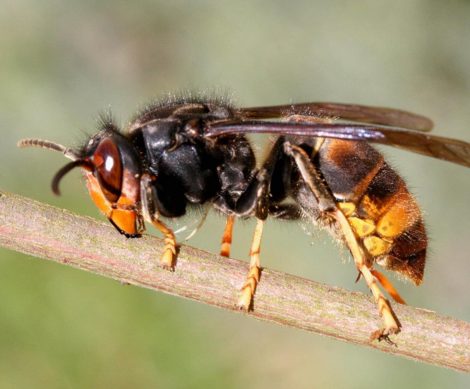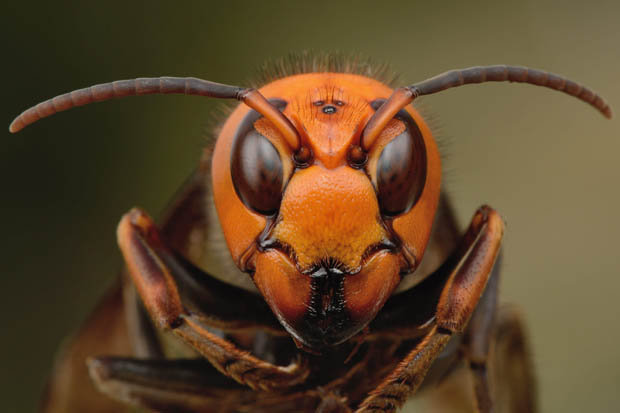 Abraham Lincoln
If given the truth, the people can be depended upon to meet any national crisis...
Abraham Lincoln
If given the truth, the people can be depended upon to meet any national crisis...
 Guildford news...
for Guildford people, brought to you by Guildford reporters - Guildford's own news service
Guildford news...
for Guildford people, brought to you by Guildford reporters - Guildford's own news service
Beekeeper’s Notes April 2017: Foreign Invaders From Europe
Published on: 1 Apr, 2017
Updated on: 2 Apr, 2017
Hugh Coakley keeps bees in Worplesdon. In the latest of his monthly notes, he talks about unwanted beasts from abroad.
If there is a sight to put fear into people, it is a huge hornet buzzing around your house.
But the hornet’s frightening reputation up to this point has not been at all deserved.
Our native hornet (Vespa crabro), seen below, is shy, eats moths and large bees. It hunts both during the day and at night and is not particularly aggressive even near its nest.

European hornet (Vespa crabro), a wasp that looks as sleek and dangerous as a fighter jet. 25mm to 35mm long, it avoids and is largely harmless to us humans. But try telling that to anyone when they see this huge, fearsome flying nightmare buzzing around their kitchen.
It is apparently quite common in the south of England mainly, but I have only ever seen one. It was quite recent, last year in our conservatory.
I bravely trapped it in a glass as much as anything, to get a good look at it.
It is an impressive creature and being local, it has a balance with the other beings and insects in the country.
On the other hand, the Asian hornet (Vespa velutina) is not local and beekeepers are fearing its imminent arrival within our shores.

Asian hornet is distinct from the European hornet. It is slightly smaller at 25mm with only one of its body segments coloured. It generally has yellow legs and an orangey or reddish face. (National Bee Unit photo).
Coming originally from Asia, it has been in France and Spain since 2004 and has spread rapidly there.
It apparently is very partial to honey. We are told that it can destroy a honey bee colony in a matter of hours by biting the head off any bee trying to defend or leave the hive.
A nest was discovered in Tetbury last September and destroyed. It is highly likely though that it will make its way across the English Channel in a fruit crate on a boat or in a container.
The public are being asked to be vigilant and to report any sightings to alertnonnative@ceh.ac.uk. Should the Asian hornet become established in the UK, beekeepers can make traps which are said in France to have reduced their nests by 90%.
The government says that they are prepared.
We wait with baited breath.
Responses to Beekeeper’s Notes April 2017: Foreign Invaders From Europe
Leave a Comment Cancel replyPlease see our comments policy. All comments are moderated and may take time to appear.
Recent Articles
- Guildford Institute’s Crowdfunding Project for Accessible Toilet in its New Community and Wellbeing Centre
- Letter: Guildford – Another Opportunity Missed?
- Letter: GBC’s Corporate Strategy – Where Is the Ambition?
- My Memories of John Mayall at a Ground-breaking Gig in Guildford Nearly Six Decades Ago
- Westborough HMO Plans ‘Losing the Heart of the Street’ Says Resident
- College Invests to Boost Surrey’s Economy and Close Digital Skills Gap
- Community Lottery Brings Big Wins for Local Charities
- GBC Housing Plan Promises ‘A Vibrant Urban Neighbourhood’ Near Town Centre
- Hospital Pillows ‘Shortage’ at the Royal Surrey
- Updated: Caravans Set Up Camp at Ash Manor School


Recent Comments
- Ian Macpherson on Updated: Main Guildford to Godalming Road Closed Until August 1
- Sara Tokunaga on GBC Housing Plan Promises ‘A Vibrant Urban Neighbourhood’ Near Town Centre
- Michael Courtnage on Daily Mail Online Reports Guildford Has Highest-paid Council Officer
- Alan Judge on GBC Housing Plan Promises ‘A Vibrant Urban Neighbourhood’ Near Town Centre
- John Perkins on GBC Housing Plan Promises ‘A Vibrant Urban Neighbourhood’ Near Town Centre
- S Collins on GBC Housing Plan Promises ‘A Vibrant Urban Neighbourhood’ Near Town Centre
Search in Site
Media Gallery
Dragon Interview: Local Artist Leaves Her Mark At One of England’s Most Historic Buildings
January 21, 2023 / No Comment / Read MoreDragon Interview: Lib Dem Planning Chair: ‘Current Policy Doesn’t Work for Local People’
January 19, 2023 / No Comment / Read MoreA3 Tunnel in Guildford ‘Necessary’ for New Homes, Says Guildford’s MP
January 10, 2023 / No Comment / Read More‘Madness’ for London Road Scheme to Go Ahead Against ‘Huge Opposition’, Says SCC Leader
January 6, 2023 / No Comment / Read MoreCouncillor’s Son Starts Campaign for More Consultation on North Street Plan
December 30, 2022 / No Comment / Read MoreCounty Council Climbs Down Over London Road Works – Further ‘Engagement’ Period Announced
December 14, 2022 / No Comment / Read MoreDragon Interview: GBC Reaction to the Government’s Expected Decision to Relax Housing Targets
December 7, 2022 / No Comment / Read MoreHow Can Our Town Centre Businesses Recover? Watch the Shop Front Debate
May 18, 2020 / No Comment / Read More










Harry Eve
April 5, 2017 at 11:52 am
I too have had the good fortune to see Vespa crabro locally and also to rescue one from my garage. That was a large queen that had probably just come out of hibernation and it was so big it only just fitted in the neck of a jam jar.
It is important not to breathe on wasps and hornets when observing them closely (as I am sure most Dragon readers are keen to do!) because carbon dioxide triggers their defensive reaction. They will think you are a badger intent on raiding their nest.
I expect to see Vespa crabro in my garden every year now (see photon in article) and enjoy watching them. They used to be much less widely distributed and one of the attractions of the New Forest.
The website of the Bees, Wasps and Ants Recording Society has more on this species and an update on the status of Vespa velutina. See: http://www.bwars.com/sites/www.bwars.com/files/info_sheets/Vespa_velutina_information_sheet.pdf
It seems that the Asian Hornet can be deterred from actually entering bee hives by making the entrances smaller.
I have no wish to start another Brexit thread but suffice to say that the European Hornet is, as Hugh Coakley points outs, a British native. So, despite its name, it has every right to be here.